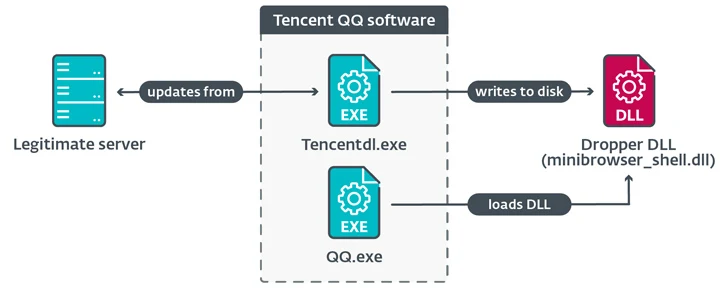

A beforehand undocumented China-aligned menace actor has been linked to a set of adversary-in-the-middle (AitM) assaults that hijack replace requests from authentic software program to ship a classy implant named NSPX30.
Slovak cybersecurity agency ESET is monitoring the superior persistent menace (APT) group underneath the title Blackwood. It is stated to be energetic since at the least 2018.
The NSPX30 implant has been noticed deployed by way of the replace mechanisms of recognized software program akin to Tencent QQ, WPS Workplace, and Sogou Pinyin, with the assaults focusing on Chinese language and Japanese manufacturing, buying and selling, and engineering corporations in addition to people positioned in China, Japan, and the U.Ok.

“NSPX30 is a multistage implant that features a number of parts akin to a dropper, an installer, loaders, an orchestrator, and a backdoor,” safety researcher Facundo Muñoz stated. “Each of the latter two have their very own units of plugins.”
“The implant was designed across the attackers’ functionality to conduct packet interception, enabling NSPX30 operators to cover their infrastructure.”
The origins of the backdoor, which can also be able to bypassing a number of Chinese language anti-malware options by allowlisting itself, could be traced to a different malware from January 2005 codenamed Venture Wooden, which is designed to reap system and community data, document keystrokes, and take screenshots from sufferer techniques.
Venture Wooden’s codebase has acted as the inspiration for a number of implants, together with spawning variants like DCM (aka Darkish Specter) in 2008, with the malware subsequently utilized in assaults focusing on people of curiosity in Hong Kong and the Higher China space in 2012 and 2014.
NSPX30, the most recent iteration of the implant, is delivered when makes an attempt to obtain software program updates from authentic servers utilizing the (unencrypted) HTTP protocol ends in a system compromise, paving the best way for the deployment of a dropper DLL file.

The malicious dropper deployed as a part of the compromised replace course of creates a number of recordsdata on disk and executes “RsStub.exe,” a binary related to the Rising Antivirus software program in order to launch “comx3.dll” by making the most of the actual fact the previous is vulnerable to DLL side-loading.
“comx3.dll” features as a loader to execute a 3rd file named “comx3.dll.txt,” which is an installer library chargeable for activating the next-stage assault chain that culminates within the execution of the orchestrator element (“WIN.cfg”).
It is presently not recognized how the menace actors ship the dropper within the type of malicious updates, however Chinese language menace actors like BlackTech, Evasive Panda, Judgement Panda, and Mustang Panda have taken benefit of compromised routers as a channel to distribute malware up to now.
ESET speculates that the attackers “are deploying a community implant within the networks of the victims, presumably on susceptible community home equipment akin to routers or gateways.”
“The truth that we discovered no indications of site visitors redirection by way of DNS may point out that when the hypothesized community implant intercepts unencrypted HTTP site visitors associated to updates, it replies with the NSPX30 implant’s dropper within the type of a DLL, an executable file, or a ZIP archive containing the DLL.”

The orchestrator then proceeds to create two threads, one to acquire the backdoor (“msfmtkl.dat”) and one other to load its plugins and add exclusions to allowlist the loader DLLs to bypass Chinese language anti-malware options.
The backdoor is downloaded by way of an HTTP request to Baidu’s web site www.baidu[.]com, a authentic Chinese language search engine, with an uncommon Person-Agent string that masquerades the request as originating from the Web Explorer browser on Home windows 98.
The response from the server is then saved to a file from which the backdoor element is extracted and loaded into reminiscence.
NSPX30, as a part of its initialization part, additionally creates a passive UDP listening socket for receiving instructions from the controller and exfiltrating information by seemingly intercepting DNS question packets with the intention to anonymize its command-and-control (C2) infrastructure.
The directions enable the backdoor to create a reverse shell, acquire file data, terminate particular processes, seize screenshots, log keystrokes, and even uninstall itself from the contaminated machine.
The disclosure comes weeks after SecurityScorecard revealed new infrastructure related to a different Beijing-nexus cyber espionage group generally known as Volt Hurricane (aka Bronze Silhouette) that leverages a botnet created by exploiting recognized safety flaws in end-of-life Cisco RV320/325 routers (CVE-2019-1652 and CVE-2019-1653) working throughout Europe, North America, and Asia Pacific.
“Roughly 30% of them (325 of 1,116 gadgets) communicated with two IP addresses beforehand named as proxy routers used for command-and-control (C2) communications, 174.138.56[.]21 and 159.203.113[.]25, in a thirty-day interval,” the corporate stated.
“Volt Hurricane might goal to make use of these compromised gadgets to switch stolen information or join to focus on organizations’ networks.”
